When people seek additional information to navigate through challenging times, that information is often wielded arbitrarily, leading to religious and political exploitation. Independent media outlets have observed a proliferation of divisive misrepresentations. Ultimately, it is the people who bear the brunt of this manipulation, being left fragmented and disempowered.
Process
The arrival of Mokha was initially likened to a comforting cup of coffee, but for residents of Rakhine, it transformed into a malevolent tempest. Compounded by the onslaught of ambiguous and unreliable information, people found themselves grappling with uncertainty about whose information to trust.
Following its path through Rakhine State, Sagaing Division, and Chin State, Mokha impacted over 5.4 million individuals, with a concentration of 3.1 million likely to bear the brunt. Despite early warnings, only 100,000 individuals in Myanmar were prepared for the storm, while over 700,000 were evacuated in Bangladesh.
The National Unity Government (NUG) reported 455 fatalities attributed to Storm Mokha, with 112 deaths in Rakhine State and Sagaing, and 6 in Magway, totaling 118. Additionally, RFA disclosed that 460 Rohingya refugees perished in the disaster.
Mokha storm information
When distrust towards government-run agencies permeates the public, opportunists exploit fears surrounding Cyclone Mokha by disseminating vague information.
On May 4th, social media platforms were abuzz with rumors predicting a severe storm akin to Nargis hitting Myanmar’s Irrawaddy and Rakhine coasts.
Internationally, Cyclone Mokha, the first of the year, was projected to intensify in the southeastern Bay of Bengal around May 6, according to announcements from the World Meteorological Organization and the Indian Meteorological Department. Forecasts indicated that the cyclone’s center would make landfall near Sittwe, with wind speeds exceeding 140 miles per hour.
Despite warnings from international bodies, Moe Zala, speaking on behalf of the Military Council, downplayed the likelihood of a significant storm in May.
Statements from the Myanmar Meteorology and Hydrology Department’s Facebook page outlined the progression of events:
May 6: Announcement of low pressure in the Bay of Bengal.
May 9: Classification as a Depression, upgraded to Cyclone Mokha on May 11.
May 11, 6:00 PM: Issuance of an orange alert as the cyclone approached the Myanmar coast.
May 11, 9:30 PM: Upgrade to a severe cyclone status.
May 12: Arrival of the severe cyclone in the morning.
May 13: Designation as an extremely severe cyclone, with landfall near Sittwe at 7:00 AM.
May 14, 12:30 PM: Crossing inland between Kyaukphyu city in Rakhine state and Cox’s Bazar region in Bangladesh.
May 15, 11:00 AM: Downgraded to a green alert after moving away from Myanmar’s territory.
Forecasts indicated maximum wind speeds of 120 to 130 miles per hour during landfall near Sittwe, with expected rainfall of 16 to 20 feet along the Rakhine coast and offshore areas.
Cyclone Mokha, characterized by winds reaching nearly 150 miles per hour according to the Joint Typhoon Warning Center, made a significant impact as it crossed inland.
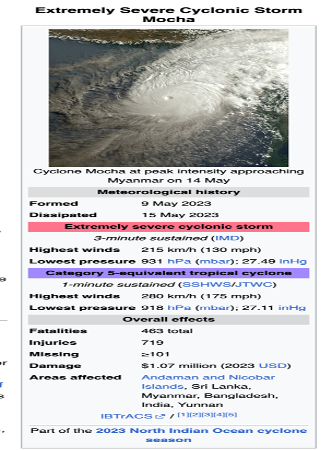
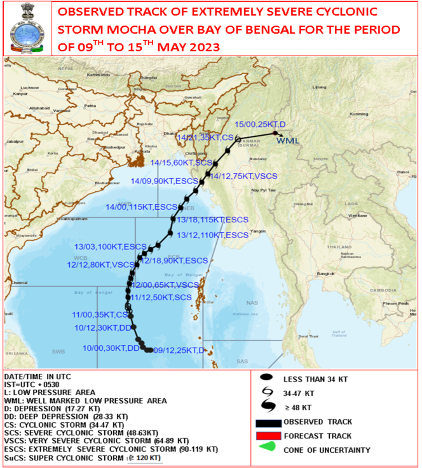
International weather stations and local meteorologists issued early warnings about the potential impact of the storm on Myanmar. Despite these warnings and media alerts, the military council appeared to prioritize religious rituals and attempts to ward off the storm through unconventional means rather than focusing on preparedness efforts.
By May 11, three days before the storm’s expected landfall, it had already been classified as a typhoon with a trajectory toward Myanmar’s coast, prompting the initiation of preparations.
Storm News:
Due to the ongoing military coup and its social and economic repercussions in Burma, the public faced challenges in preparing for the impending natural disaster posed by the Mokha storm. Obtaining accurate information proved to be difficult amidst these circumstances.
Individuals had to consult at least five different sources to grasp the full picture of the storm report regarding Mokha. These sources included announcements from the Directorate of Meteorology and Hydrology under the Military Council, storm releases from the NUG government, news reports, presentations by weather forecasters like U Win Naing, and information shared by individuals like Daw Su Su San (Min Gutid), among others.
The people encountered a formidable and potentially devastating natural calamity while grappling with vague and uncertain information. Moreover, controversies surrounding meteorologists and fake observers further eroded trust in the available information. Screenshots showcasing such contentious discussions and comments can be found below.
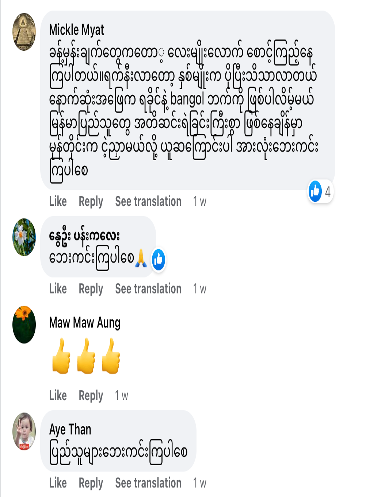
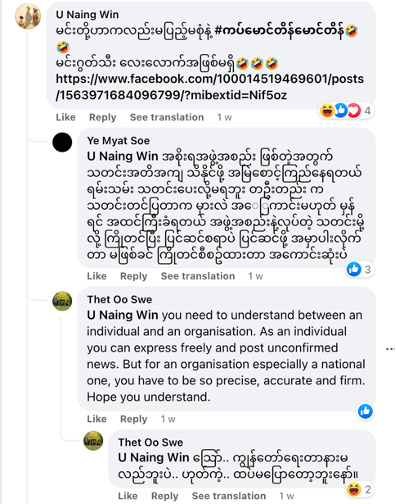
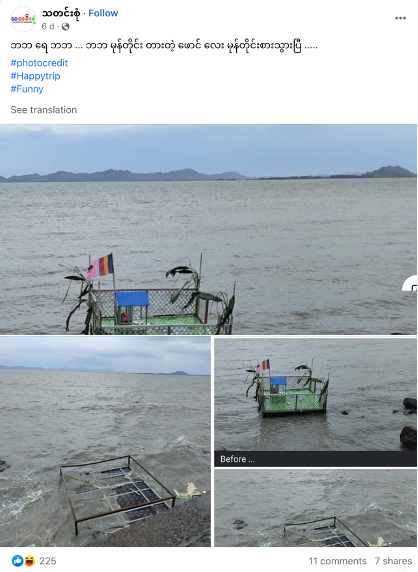
Weather presenters were also prone to inaccuracies, further complicating the situation. Controversy surrounding misleading forecasts surfaced on May 14, the day the storm made landfall.
An account detailing online fraud detection is provided below for reference.
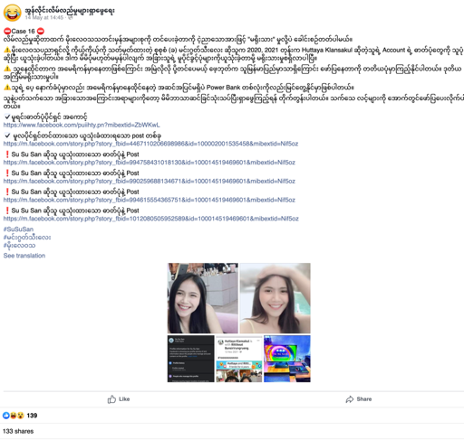
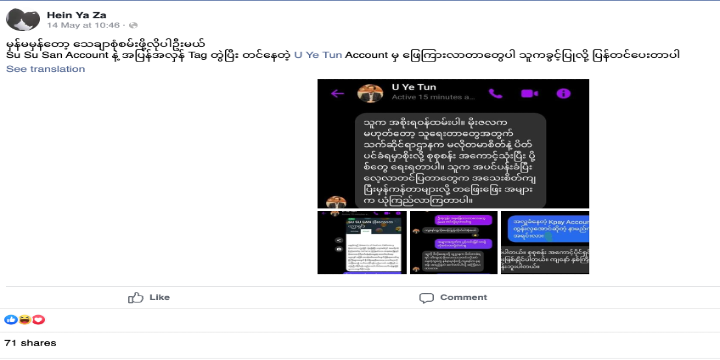
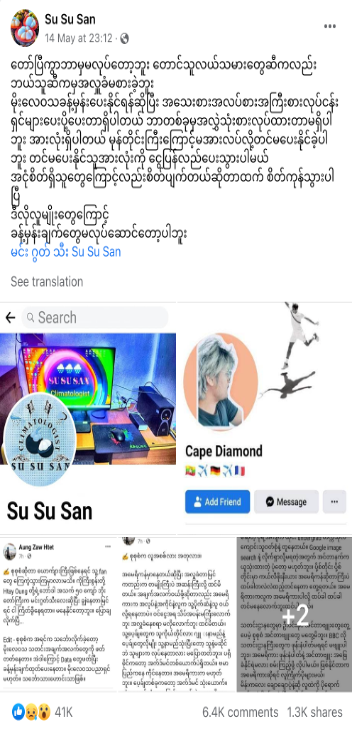
Vague news
The Military Council announced the orange level only three days before the storm. However, during this time, they disseminated false information through military lobby channels, engaging in propaganda and spreading misinformation extensively. Misinformation was disseminated across various platforms including Facebook, Telegram, YouTube, Twitter, and TikTok. We have collected and studied nearly 40 instances of misinformation related to the Mokha storm case study.
Below are the details of the links, although some may be broken due to re-takenowns. As The Red Flag, we have saved screenshots for study purposes, allowing us to analyze and select specific contents for examination.
Spreading False Information Using Religion
On May 8, it was falsely claimed that the approaching storm had altered its course due to the devotion to the Three Jewels and the actions of the coup army. This misinformation was disseminated widely through the Kyaw Swar account, which boasts tens of thousands of followers. The false claim gained trust and was widely circulated, as evidenced by the screenshots provided below.
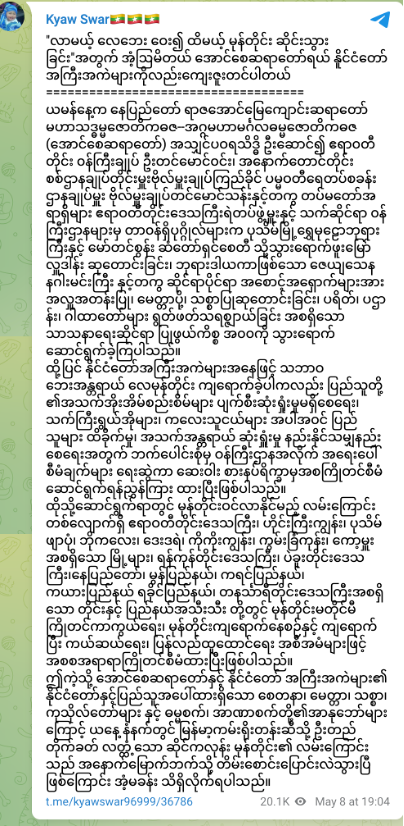
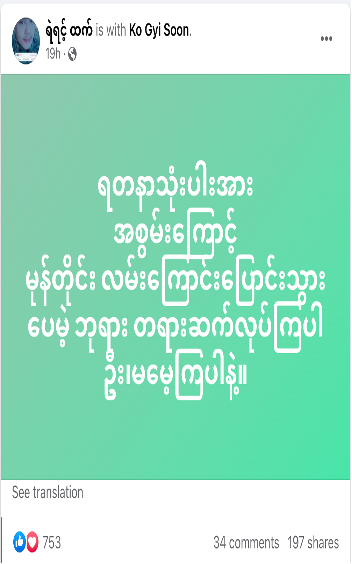
On May 11th, as it became evident that the storm would make landfall in Myanmar, it struck Sagaing, an area known for its strong military and revolutionary presence. False information began to circulate, exploiting religious beliefs by claiming that the storm’s approach towards Chin was a sign that it would drive away malevolent individuals.
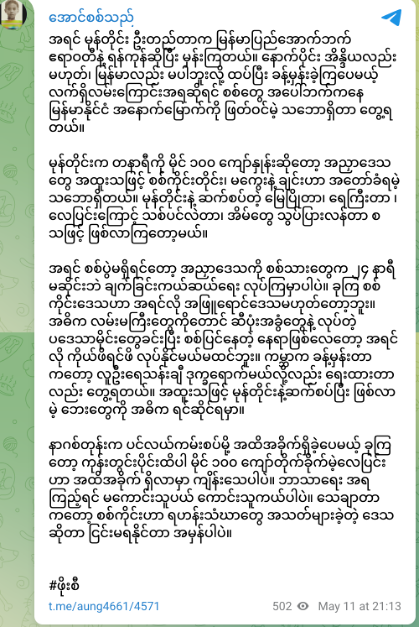
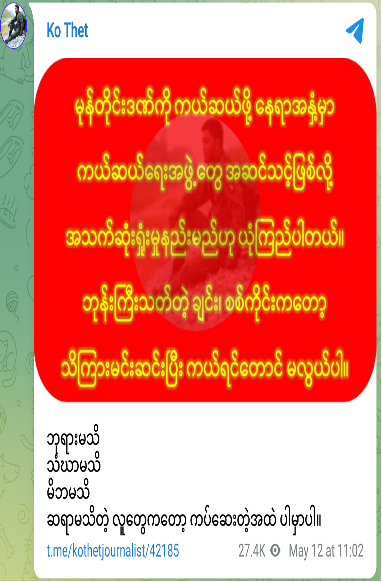
Storm-based propaganda for political exploitation
The military council used relief and recovery operations in storm-affected areas, including military aircraft, vessels, and trucks, to spread propaganda. They portrayed themselves as the only entity capable of assisting the Burmese people in times of emergency while undermining the legitimacy of the NUG. Additionally, ethnic revolutionary forces were depicted as unable to provide real assistance.
Despite numerous deaths, the military council and its affiliated media outlets did not acknowledge the casualties in Rohingya refugee camps in Rakhine until video footage of the funerals surfaced on social media and news outlets. This delay in acknowledgment was likely due to the political exploitation of the situation. It was later revealed that many Rohingya deaths resulted from the military’s failure to heed warnings. Finally, on May 19, the Military Council issued an official press release acknowledging the Rohingya deaths.
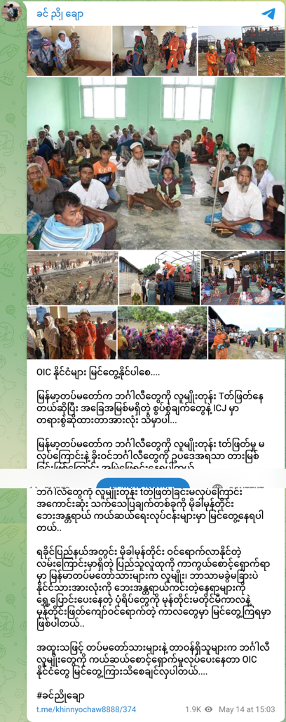
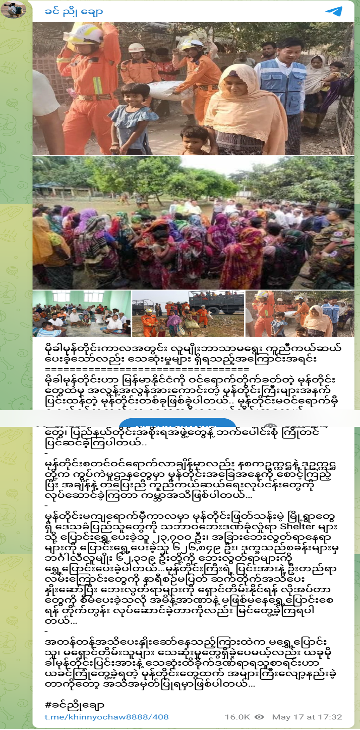
Below are the links to the spread of misinformation collected for study.
- https://t.me/kyawswar96999/36786
- https://t.me/kyawswar96999/37181
- https://t.me/kyawswar96999/37106
- https://t.me/khinnyochaw8888/374
- https://t.me/Phoesi01233/14982
- https://t.me/kothetjournalist/42244
- https://t.me/aung4661/4568
- https://t.me/aung4661/4571
- https://t.me/aung4661/4680
- https://t.me/linnnnay/5130
- https://t.me/nyein96999/2589
- https://t.me/kyawswar96999/36963
- https://t.me/babanyunt/7095
- https://t.me/kothetjournalist/42185
- https://t.me/babanyunt/7789
- https://t.me/hminewai/31107
- https://t.me/hminewai/31002
- https://t.me/kothetjournalist/42629
- https://twitter.com/moesatkhinn/status/1658713508941545473?s=46&t=pVcXWkpQqummAaY4wWDnKg
- https://t.me/kyawswar96999/37298
- https://t.me/khinnyochaw8888/408
- https://www.tiktok.com/@soesandikyaw718/video/7232976838090394881
- https://www.facebook.com/permalink.php?story_fbid=pfbid0sESXH8d6bx3VLUZCm4Y8cWPTsjLA5zWxeCzhNHMUetPVCzDFneFboiSQTjTd1vSQl&id=100077341815162
- https://www.facebook.com/MyanmarLiveUpToDate/posts/pfbid0j4acTw2Vc6VHTxpWJaZHF1VdtPPuAvbR999jPWR9TAUcEpRGa6U3QzBcDM5Kj5B9l
- https://www.facebook.com/groups/1190091364403228/posts/6358365670909079/
- https://www.youtube.com/watch?v=wS50_ZHMwGU
- https://www.facebook.com/groups/1191564874305271/permalink/6009539839174393
- https://www.facebook.com/permalink.php?story_fbid=pfbid021cXmE6C4DjyxFzboV5Exy48jVApVeNm9EVrCqzUBWH1oZfLFhXip1tDxDeTodaqyl&id=100091576849860
- https://www.facebook.com/permalink.php?story_fbid=pfbid0hS12umwxm3a3RiSVfx9M9XRh7Rwk4y4ipUy9qYAoaEP6Hi7HCLa8WoLxEeYvKpVDl&id=100091576849860
- https://m.facebook.com/story.php?story_fbid=pfbid0aiZKq4ZeCCb647otc4MJwgbjQX8UbsVZCsaM8GZ3MhhjAdRTwm49cxgjhaiqDtyQl&id=100791049325976&mibextid=Nif5oz
- https://www.facebook.com/photo/?fbid=631451459027935&set=pcb.631454349027646
- https://www.facebook.com/shwemyanmar22/posts/pfbid02asx1HGa6bzTVRnTWjt59pskqsNofT5ufKqinBRfj7s73Y8QAAkVSdeQQreFaSv7il
- https://www.facebook.com/MyanmarLiveUpToDate/posts/pfbid05NC5YM2xT2MkscETMAAiD5KwL8pCtqMstg46YSa75H5hSS5fAiL3eNBWVyfNtMMil
- https://www.facebook.com/groups/1191564874305271/permalink/6036024186525958
- https://www.facebook.com/usandi.ma.503/posts/pfbid0i6LMi9VxTbmUaYieAUdf7Rz4USGWFqFWpgSrWa312fVcALUcCeRV5cJ6gjs1GjxKl
- https://www.facebook.com/watch/?v=270898165376409
Distributing trusted media
News outlets that are trusted and watched by the public have been deliberately publishing the news of the Rohingya, not reporting the important news about the storm that the public should know.
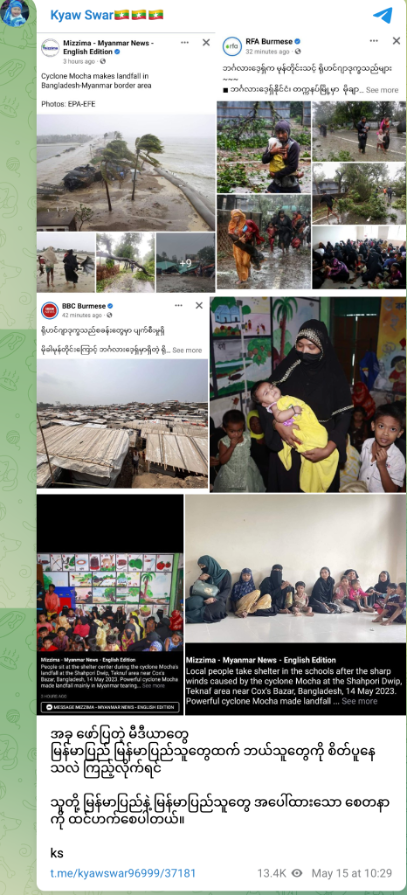

As mentioned above, RFA, BBC, and Mizzima news agencies presented storm news in a timely manner, including about the Rohingya refugees affected by the storm. News outlets that have been notified of storm forecast news in advance.
The military council lobby emphasized the news related to the Rohingyas among those news broadcasts and spread them with the aim of creating a rift between the public and the news media.
Media presentations
Based on the news of the Mokha storm from the military council and the military support accounts, the media and the public were divided, but the following information testifies that the news outlets provided the news of the natural disaster promptly to the public.
According to the data studied by Data For Myanmar -D4M as The Red Flag, as of May 19, 108 media and Facebook pages have presented a total of 1,220 news about Mokha. Some of the news links are listed.

- The military council announced that the Mokha storm will hit up to 110 miles per hour
- Warned ships and fishing boats not to leave at all
- Mojala said that there is a danger because the intensity of storms Mokha and Nargis are similar
- Cyclone Mokha is headed towards the coast of Bangladesh and Myanmar
- AA leader says Rakhine needs help because of Cyclone Mokha
- Cyclone Mokha: The whole state of Rakhine is damaged and destroyed. The death toll may increase
- Sittwe City is hit by the Mokha storm
- The military council said that more than 100 Rohingyas died due to the Mokha storm
- Storm-stricken Rohingyas do not get help in time; which May increase the mortality
- The military council threatens to take action regarding the death toll of the storm
- Accused of spreading false news to scare the public
- Ko Maung Sein, who lost his pregnant wife and young son, and the helpless Rohingya refugees during the storm
- RFA Conversation “The War Council and the Mocha Storm”
- Storm-affected people along the Rakhine coast
- 15 Basara Rohingya villagers killed by storm
- Rakhine philanthropist says that international aid will be effective in storm relief
- International aid has not yet arrived on the ground (video/audio)
- The aftermath of the Mokha storm, which “rained and rained where misfortune did not go”.
- Why were there so many casualties in Cyclone Mocha (video/audio)
- NUG told to allow free transportation of flood relief materials (video/audio)
- The British government will provide 2.5 million dollars for the people of Burma affected by the storm
- Indian Navy ship arrives to provide relief supplies
- Generals tasked with storm recovery
- The city of Rati Taung, which was hit by the storm, faced another fire
- What do you think the wind speed of the cyclone that entered Rati Taung Township will be (TV)
- The NUG provided one million dollars for the emergency response to the Mokha storm, and the military council said that it would support 700,000 kyats.
- Due to the cyclone, more than 400 people died in Muslim relief camps in Sittwe Township and hundreds are still missing.
The summary review highlights the aftermath and impact of the storm as follows:
- The awareness of the approaching storm began in early May, but uncertainty persisted until its arrival.
- Trust in news sources regarding the storm was questioned, contributing to confusion among the public.
- Despite forewarning about the storm, the military council focused more on other priorities rather than preventive measures.
- False reports circulated, possibly influenced by the military, suggesting the storm would not affect Myanmar.
- The storm compounded existing challenges, including ongoing conflicts, exacerbating the situation for affected regions.
- Communication breakdowns during the storm left affected individuals without vital information, resembling a state of isolation.
- Limited access to reliable information, particularly in remote areas like Rohingya camps, underscored the reliance on traditional media like radio.
- Despite warnings, some individuals in storm-affected areas hesitated to evacuate due to mistrust in the military council.
- The Rakhine Army facilitated the evacuation of over 100,000 people in areas under its control, potentially reducing casualties.
- Significant damage, including fatalities, occurred in Rakhine State, contrary to the military council’s portrayal of minimal impact.
- Discrepancies between official figures and ground reports raised questions about the accuracy of casualty counts, particularly in Rohingya camps.
- The military council faced criticism for its handling of the storm aftermath, including accusations of victim-blaming.
- Official announcements belatedly acknowledged Rohingya fatalities, highlighting a delayed response to humanitarian crises.
- Several townships in Rakhine and Chin States were severely affected by the storm, with villages destroyed and numerous casualties.
- Communication challenges hampered efforts to compile accurate casualty lists, suggesting the death toll could be higher than reported.
- Concerns about the storm extended beyond affected areas, with misinformation circulating widely on social media platforms.
Overall, the summary underscores the complex challenges faced in the aftermath of the Mokha storm, including issues of trust, communication, and accountability.
The impact of the Mokha storm extended beyond physical destruction, causing widespread disruption in public life and exacerbating information chaos. The combination of a war council and propaganda media, fueled by public distrust, only compounded the damage. Instances of religious and political exploitation thrived amidst the chaos, taking advantage of vulnerable communities in need. A fractured information ecosystem further intensified societal harm during this critical period.
